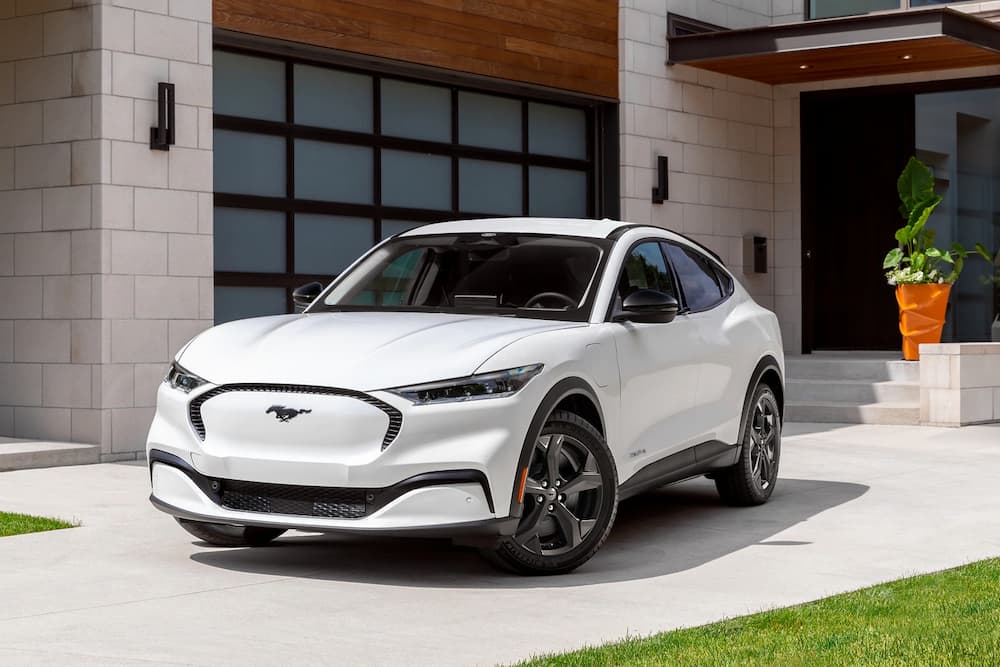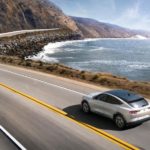The Ford Mach-E marks the latest entry in the “models you never thought would see an electric version” category. Essentially an all-electric crossover SUV inspired by the brand’s iconic Mustang pony car, the Mach-E joins with the all-electric F-150 Lightning to prove how far the EV category has come since the wedge-shaped utilitarian models of old. By combining the Mustang’s classic look with a cutting-edge EV powertrain, Ford has brought the model firmly into the modern day, proving that going green can be stylish and even—dare we say it—fun. This crossover truly offers the best of both worlds, giving drivers more than 300 miles of range while also honoring the Mustang legacy with a 480 hp GT Performance Edition model that can rip from zero to sixty in as little as 3.5 seconds.
The Mach-E has garnered its fair share of attention from drivers and critics alike since its debut in 2021, earning an EV of the Year award from Car and Driver and flying off the lot at an impressive rate. In fact, by April of 2022, Ford has stopped taking new orders for 2022 models, citing unprecedented demand and leaving customers hungry for more. Now available at your local Ford Mach-E dealer, the 2023 model should help to satiate some of that demand, with Ford making a number of notable upgrades to its muscle car-inspired crossover. The Premium trim offers an improved range over the 2022 model while adding Ford’s Co-Pilot360 driver-assistance tech as a standard feature. The GT and GT Performance Editions will receive a new glass roof, and the latter is eligible for the stylish new Nite Pony package that adds 20-inch gloss black wheels.
Ford has made a significant investment in the all-electric future, building two new, state-of-the-art plants that will produce the next generation of electric vehicles and batteries. Located in Stanton, Tennessee, the $5.6 billion BlueOvalCity complex aims to be one of the most advanced and efficient auto production facilities in the world, employing over 6,000 to meet the strong demand for Ford’s all-electric F-Series pickups. The Tennessee facility will be complemented by another major project in Glendale, Kentucky, where 5,000 workers will staff two battery plants to provide juice for forthcoming Ford and Lincoln EV models. Between the Kentucky and Tennessee facilities, Ford will be able to produce some 129-gigawatt hours of battery production capacity per year.
The projects represent a forward-thinking investment from Ford, but in many ways it’s also nothing new. As one of the stalwarts of the American auto industry, Ford has been a major driver of electric vehicle innovation for over a century. Let’s take a trip through time to explore the origin of the EV, look into Ford’s first EV experiment, and see how the industry has—albeit hesitantly—come to embrace the trend.
First Jolt
The first electric vehicles were a far cry from the Mach-E with its 307-mile range and top speed of 114 mph. Built by two Scotsmen, Robert Anderson and Robert Davidson, these fledgling EVs first hit the road back in the mid-1800s and could travel just 1.5 miles. Worse still, batteries at the time weren’t rechargeable, making early EVs an exceedingly impractical choice that amounted to little more than an ambitious concept. Another Scot (there must be something in that loch water) would make a splash at the 1893 Chicago World’s Fair with a four-horsepower, front-wheel drive EV powered by 24 rechargeable battery cells. With a top speed of 20 mph and the need to recharge every 50 miles, this EV wasn’t a game changer, yet it would pave the way for future models.
The first commercially available EV would arrive in 1894 when Pedro Salom and Henry G. Morris patented the Electrobat, a rear-steer carriage that employed two 1.1 kW motors to achieve a blazingly fast 20 mph. With the dominance of gas-powered vehicles yet to be firmly established, EVs would have a bit of a heyday in the early 1900s. The Electric Vehicle Company (EVC) operated more than 600 electric cabs in New York City with smaller operations in Boston, Baltimore, and across the East Coast. As the industry grew, more famous names would try their hand at the EV market, including Studebaker, Oldsmobile’s Ransom Eli Olds, and Dr. Ferdinand Porsche.
Largely focused on getting the game-changing Model T out into the world, Henry Ford was not an early adopter of EV technology—but his wife was. Given the fact that they often cost twice as much as their gas counterparts, EVs were a bit of a novelty in the early 1900s, but they were an alluring alternative for monied drivers who didn’t want to deal with the hassle of cranking a gas-powered vehicle to life. Clara Ford, who was said to find her husband’s vehicles to be noisy and dirty, could be found motoring around Detroit in a series of EVs from Detroit Electric, but it was Thomas Edison who would finally convince Henry Ford to experiment with the newfangled technology.
Long-time friends and camping buddies, Ford and Edison met at the Wizard of Menlo Park’s 50th birthday party while Ford was working as the chief operating engineer of the Edison Illuminating Company of Detroit. The two legends of American engineering would quickly hit it off, developing a lifelong friendship that would prove inspirational—and profitable—for both men. Edison would be the first to tackle the EV dilemma, producing a battery-powered reverse tricycle in 1898 after making a breakthrough with nickel-iron battery chemistry that boasted a 100-year lifespan. The inventor saw the potential for electric vehicles, which he thought would address many of the issues that made gas-powered cars so unappealing to drivers like Clara Ford. “Electricity is the thing,” Edison said. “There are no whirring and grinding gears with their numerous levers to confuse. There is not that almost terrifying uncertain throb and whirr of the powerful combustion engine. There is no dangerous and evil-smelling gasoline and no noise.”
Enter the Edison-Ford
Edison’s experiments in the EV realm would result in the founding of the Edison Storage Battery Co., which sold Edison batteries to leading EV makers like Baker and Detroit Electric. Edison would soon move on to his next venture, but Ford took inspiration from his friend’s work in 1913 when he started tinkering with his own EV designs. By this time, the Model T had firmly established itself as a veritable phenomenon, with Ford selling over 180,000 units in just five years, giving the auto magnate enough breathing room to look toward the future. Ford envisioned an electric version of the Model T that would cost just $500, opening up the world of electric vehicles to the masses with a price that was only slightly higher than a gas-powered version of the car.
While Edison’s involvement in the project was largely limited to being Ford’s battery supplier, the project was dubbed the Edison-Ford and, by 1914, a prototype was well underway. Comprised of a Model T frame, suspension, front axle, and steering wheel paired with a worm-drive rear axle and batteries located underneath the driver’s seat, this EV was capable of traveling between 50 and 100 miles on a single charge. While the relative lack of mileage might seem like a limiting factor, the rarity of intercity travel meant that the range would be more than enough for most drivers.
Ford was rumored to have put his son Edsel in charge of the EV project, and there were reportedly plans in the works to establish an Edison-Ford EV factory in downtown Detroit, but whether these were actual plans or just part of the legendary Ford PR machine is hard to know. One thing is for sure: the EV never saw the light of day. The Edison-Ford was supposed to go on sale by 1915 or 1916 but would remain little more than an ambitious concept in the end. There are multiple reasons cited for the EV’s failure—pressure from oil cartels, a suspicious fire at Edison’s Menlo Park labs, etcetera—but the more likely reason has to do with the advent of the electric starter. When the technology hit the market, and crank-start vehicles began to disappear, EVs lost one of their major advantages over their gas-powered counterparts. After pairing this with the higher cost and the relative hassle of recharging their batteries, Ford’s EV days were numbered.
Ford would continue to dabble in the EV space over the subsequent decades. The automaker showcased the Comuta minicar EV in 1967 but the project failed to move past the concept stage, with executives expressing pessimism about the demand for such a vehicle. They weren’t far off as, even some 30 years later, the company failed to find a market for its Think City microcar. Ford purchased Norway’s Think Global in 1999, hoping to produce a small EV with a 53-mile range and top speed of 55 mph, but only ended up producing around 1,000 units before putting the Think division back up for sale in 2002.
If there’s one bright spot in Ford’s EV history, it would be the Ranger EV, an all-electric version of the brand’s popular compact pickup. Built from 1998 to 2002, the Ranger EV was built on a converted Ranger XL 4×2 Regular Cab. Selling for around $50,000, the Ranger EV had an 80-mile range but suffered in longevity, with the average model experiencing diminished battery range after 25,000 miles. When California weakened its emissions rules in 2003, Ford gave up on the Ranger EV with only 1,500 units sold, and the brand’s EV dreams went back into hibernation. Shortly after the Ranger EV’s demise, the Toyota Prius would pop onto the American scene, sapping demand for EVs and paving the way for hybrid vehicles as the go-to choice for environmentally conscious drivers in the early 2000s. The Prius might have temporarily diverted the industry from the all-electric track, but the model’s success did go a long way in proving that electric powertrains were a viable option for the mass market. As technology advanced, all-electric EVs have started to eat into the hybrid’s market share, becoming increasingly common with every passing model year.
While the 2023 Ford Mach-E might be challenging the status quo for just what an EV can be, it’s really just the latest chapter in Ford’s long EV history. This stylish EV crossover—with its bold design, 300-plus-mile range, and blazing acceleration—is a far cry from the skeletal Edison-Ford of 100 years earlier, but it captures the same spirit of innovation that’s made Ford such an American success story over the last century. From early experiments with Thomas Edison to concept models and short-lived production vehicles like the Ranger EV, Ford has long been on the cutting edge when it comes to embracing alternative fuels and new technologies. It’s of little surprise, given Ford’s reputation for innovation, but it’s still nice to see the storied brand taking the lead in producing a new generation of EVs that drivers will actually be excited to take for a drive. The 2023 Ford Mach-E is all that and more, leveraging the Mustang reputation to win a new breed of drivers over to the EV lifestyle.






